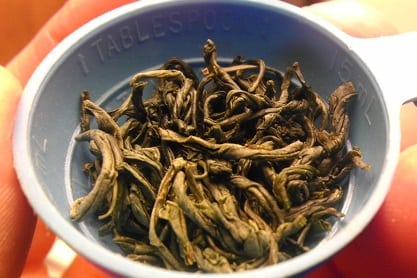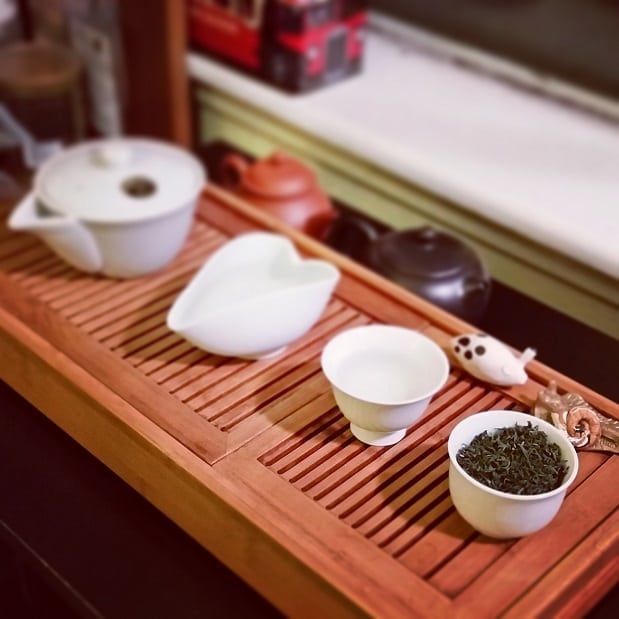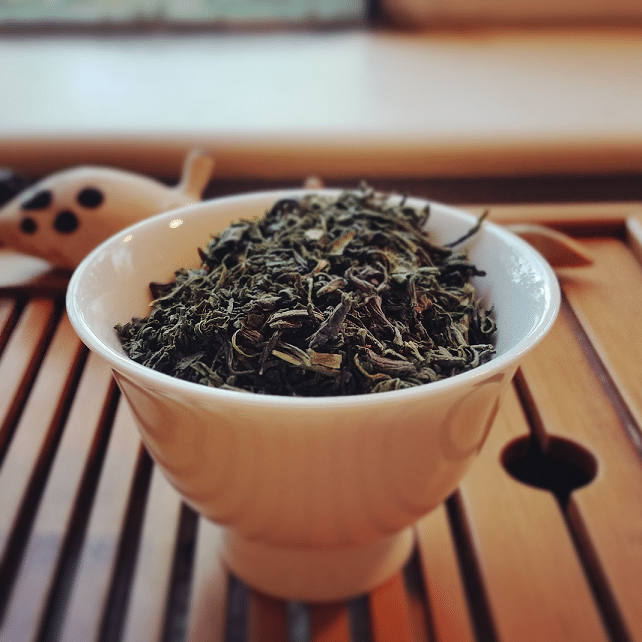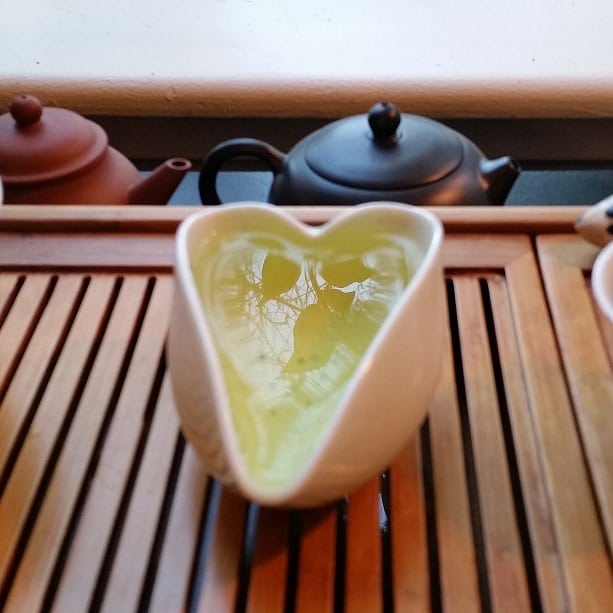Kamairicha literally means “pan-fired tea” in Japanese.
I first tried it a year ago, and I dug it. I even wrote a poem about it. The less spoken about that, the better. Moving on . . .

The technique of pan-firing (or frying) green tea was something not commonly utilized by the Japanese. It was considered a Chinese processing method. Steaming tea leaves was the chosen kill-green process among most Japanese tea growing regions. Well . . . the island of Kyushu – in Kagoshima Prefecture, to be precise – is not your typical tea growing region.
Like the folks in neighboring Kumamoto Prefecture (also on Kyushu), things are done a little differently. Many sencha green teas aren’t processed the same way. Leaves aren’t cut and flattened using atypical methods. In Kumamoto, young tea leaves are kept mostly intact and allowed to “curl”. The result is a green tea called tamaryokucha (or guricha), which literally means, “curly green tea”.
Tea growers and processers in the Miyazaki mountain area kinda took that style . . . and further futzed with it. Instead of steaming the leaves – like with tamaryokucha – they pan-fired them, or subjected them to other dry heating techniques. The result? Kamairicha. It was a lot like tamaryokucha, but dried differently.
Make sense? No? Well, allow me to confuse the issue even further.
About a month ago, a company in the U.K. called The Gilded Teapot got a hold of me over Twitter. They said, “I have a kamairicha from the saemidori varietal looking for some tastebuds.”
The Japanese were really proud of their extensive catalogue of tea plant cultivars. Even I must confess that I’m not well-versed in . . . well . . . any of them. Luckily, I have tea friends who are. Specifically, Ricardo Caicedo of the My Japanese Green Tea blog; he actually did an extensive write-up on the saemidori cultivar.
Apparently, it was a hybrid – a cross between the asatsuyu and [the more common] yabukita cultivars. The former was a high quality plant, but was prone to die-off during seasonal frostbit. Yabukita – on the other hand – was a burly ol’ tea tree. In 1969, a cross was created emphasizing the desirable traits of the asatsuyu, but with the resistant qualities of the yabukita. The hybrid was officially registered in 1990.
A package arrived a couple of weeks later, and I happily dug into the kamairicha one night.

I started getting into this habit of brewing up a tea for “review” off the record first. Simply for the enjoyment of it. Not sure why I started doing this. I felt that, if I had enough of the tea to play with, it needed a fair shake without any pressure for analysis. First impression? It was really sweet. And not too grassy.
When the time came to finally do a closer examination of this tea, it happened to be Saint Patrick’s Day. It was the first time in over five years that I had that day off . . . and I no longer drank alcohol. So, a green tea sounded like the perfect plan.
Just like tamaryokucha, the leaves were exactly what I expected – small, curly and green.

The only surprise was just how small they were. The last time I had a kamairicha, the leaves were curly and small, but also fairly plump, and light-green in color. These were the typical sencha shade of dark green, but still retained their curliness. The scent, though, was all pan-fried awesomeness – nuts, sweetness and butter.
The Gilded Teapot recommended a brewing time and temp of fifty seconds in 75C water. That was roughly 155F in ‘Merican measurements. I adhered to that to the letter. Once again, I used my Takeo Maruei teapot because . . . well, that’s what it was made for – sencha stuff.
What surprised me first off was the pour. The liquor on this thing came out a beautiful soft, slight and silky green.

Pan-fired greens usually came out quite light – depending on the frying – whereas steamed greens came out radioactive bright. But this was a lovely “painting-canvas-perfection” shade of green. The aroma was just like the scent, sweet-‘n-buttery with a grassy bend. The taste was probably the smoothest of any sencha I’ve had in a while. No vegetal intro, no overcompensated vegetal characteristics, no noteworthy comparison to artichokes; it was all smooth and sweet. Not something I would associate with Japanese green teas – even my favorites.
After I was done being all “science-y” with this sucker, I brewed it up a couple more times. The leaves were that resilient. They put up with multiple brews. I didn’t pay attention to time or temperature; I just let them do their thing.

It was just . . . beautiful. Japanese tea processing stuff and the cultivar crap made little sense to me. Appreciating the beauty of the brew, though? Yeah, I’m an expert at that.
To buy this tea, go HERE.
To see where I got all my information from – My Japanese Green Tea – go HERE.
Leave a Reply to Rodino Ayala Cancel reply